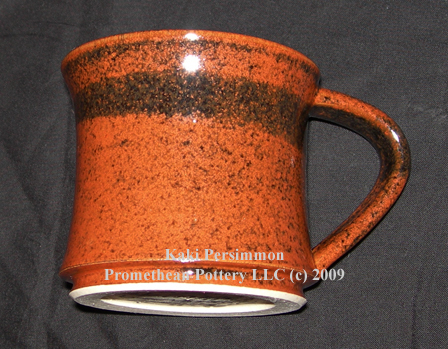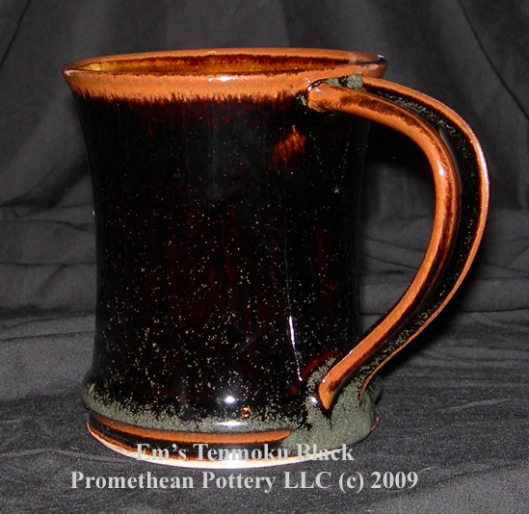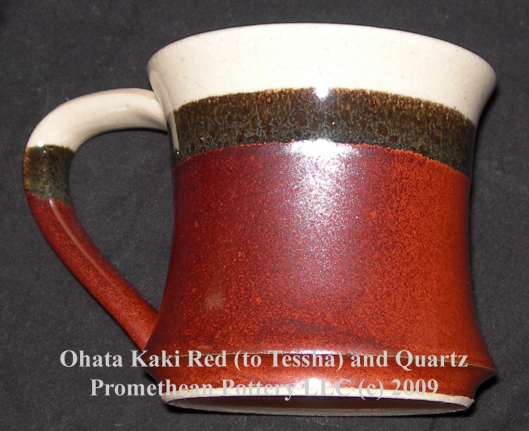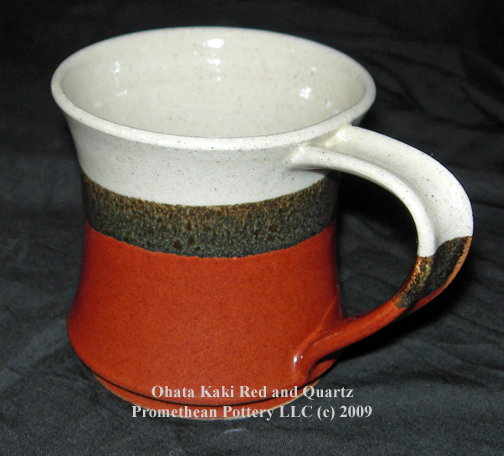Tags
Amber, Asian, Celadon, cone 10, Em's Persimmon Glaze, Em's Tenmoku Glaze, handmade, jargon, Nuka Glaze, Ohata Red Kaki Glaze, pottery, Promethean Pottery, saturated iron glazes, stoneware, Tea Dust
Very few glazes – in my opinion – have not been made by someone somewhere before me. I’m not talking about specific recipes, but instead the look of a glaze which can be accomplished by multiple formulae. This is especially true of all the lovely glaze types made by Chinese and Japanese potters over the centuries. More often than not, if you develop a glaze – especially an iron containing glaze – it has a precedent elsewhere. Add to this the fact that I’m a stickler for accuracy, and you get the article I am about to write.
It happened like this. I start messing around with glaze recipes and test firing things, and Robert off-handedly says something like, “Oh, that’s a Kaki glaze,” and I have to know if that’s right. The last thing I want is for someone to think we’re idiots because we don’t even know what to call our glazes. Now, I could get around this (and have in some cases) by giving our glazes unique names a la “Midnight Peacock”. If you come up with it, you can name it anything you like. However, I have started to feel more connected to the history of pottery. This is an old – really old – craft and we are continuing a very respectable tradition. So, if I happen to generate, de novo, a glaze recipe that when fired, looks very much like something ancient, I would like to give it a name which reflects that.
So, there are lots of iron-containing glazes that range from pale green (celadon) to black (tenmoku). In this article, I won’t talk about celadon as this requires a reduction atmosphere – which I don’t do; so, I don’t feel qualified to talk about them. I also won’t talk about amber glazes which I haven’t done a lot of work on up to this point. Most of what I have been working with lately includes iron-containing glazes where the iron (both red and black) is 8-15% of dry weight. I’ve done a decent amount of research into what different looking iron glazes should be called with respect to history. That research is summarized here as “iron glaze taxonomy” and includes the following types: Kaki, Ohata Kaki, Teesha, Tenmoku, Hare’s Fur, Oil Spot, Tea Dust, Partridge Feather, and Tortoiseshell. I have to say that a lot of these glazes seem to have been popularized-revitalized-westernized though the legendary collaboration between Hamada Shoji and Bernard Leach.
NB – Sometimes, it seems a name refers to a glaze as well as a form. I have noted these redundancies where applicable.
Kaki (Persimmon)
- Emily’s Description: A saturated iron glaze that is brick red with black speckles the density of which changes depending on how thickly the glaze is applied. I like the metallic black speckles and tend to apply my Persimmon on the thicker side as in the photo below.

Notice how the density of black flecks increases with increasing thickness of the glaze.
- Real Definition(s) from Multiple Sources:
- A feldspathic glaze containing liberal amounts of iron which crystallizes during cooling. This glaze originated in Mashiko, Japan and utilizes local rock.
- According to Shoji Hamada a kaki glaze has the color that a persimmon is on October 24. ***NB: I am not sure what a persimmon looks like on Oct 24, but from looking at pictures of persimmons, this glaze looks more like a dried persimmon (brick red) than a fresh one (orange). Go to Wiki http://en.wikipedia.org/wiki/Persimmon for pictures of fresh and dried persimmons.
- A glaze requiring reduction atmosphere during cooling. ***NB: I do not utilize reduction in my kiln for my “Persimmon” glaze (or any other). Additionally, Bernard Leach mentions in A Potter’s Book that the color is due to oxidized iron crystals. I tend to agree with this definition.
- Kaki-no-heta – Best I can tell, this is a rust iron colored glaze used on chawan (tea bowls) first made in Korea that were imported into Japan. I have more to say about this under Ohata, below.
- Simply, kaki is Japanese for persimmon.
- Kaki can also refer to the shape of a particular flower vase.
Tenmoku
- Emily’s Description: A high-iron, feldspathic glaze that has more flux than the other high-iron glazes covered here (traditionally due to wood ash, but in contemporary recipes flux can be from other sources). Tenmoku glazes can have different surface textures. Mine is a Honan style as shown in the photo below.

I am very proud of my Honan style tenmoku. It's a glossy deep black over the body that breaks to rust red on the edges. Also, where it pools, grey-green crystals have formed (base of handle).
- Real Definition(s) from Multiple Sources:
- Chinese potters had developed many high-iron glazes for their tea bowls. The dark black and brown glazes were very common initially but fell out of favor except for some areas in southern China. Japanese monks visiting a temple on a mountain between the Zhejiang and Anhui provinces (Mount Tienmu) saw the iron glaze and brought examples back to Japan. Japanese potters worked hard to recreate the glaze which they called tenmoku after Tienmu.
- Types of Tenmoku
- Honan = Brown and Black (http://www.kyohaku.go.jp/eng/dictio/data/touji/tenm01.htm)
- Yohen = literally, Stars Glistening in a Night Sky, where each spot is iridescent in color (stunning contemporary versions at http://www.miyamurastudio.com/)
- Bizen = Hare’s Fur (streaking form – http://en.wikipedia.org/wiki/File:Hares_fur_IMGP3594.jpg and http://www.kyohaku.go.jp/eng/dictio/data/touji/tenm04.htm)
- Yuteki = traditional Oil Spot (http://www.e-yakimono.net/guide/html/tenmoku.html)
- ? = Partridge Feather (black tenmoku with spots of a white glaze applied before firing, NOT the same as Hare’s Fur, see Nigel Wood)
- Haikatsugi (ash covered, often applied over a yellow underglaze – http://www.miho.or.jp/booth/html/imgbig/00005410e.htm)
- Taihisan or Taihi = Tortoiseshell (http://www.kyohaku.go.jp/eng/dictio/data/touji/tenm03.htm)
Tessha
- Emily’s Description: A saturated iron glaze which is predominantly rust red but exhibits areas of metallic sheen. My Ohata Kaki Red came out of the kiln with a silvery-purple sheen on one side (kiln wall side) as shown in the picture below.

On the kiln wall side of this mug, the Ohata Red has acquired a metallic purple sheen indicative of Tessha. This illustrates how critical cooling rate is to the formation of crystals for some of these iron glazes.
- Real Definition(s) from Multiple Sources:
- A Japanese glaze with purple-red or silvery areas due to the oxidation of iron crystals formed upon slow cooling, often mottled with patches of brown or black – similar to kaki.
- Specifically, tessha refers to an iron-rich alluvium which is used in under painting or as a colorant in glazes. Thus, it can also refer to the glaze of which it is a constituent, tessha-yu or iron sand glaze.
Tea Dust
- Emily’s Description: A high-iron glaze that has predominant green markings sometimes on a grey-black or very dark brown background, usually satin to matte finish. According to John Britt, these require some magnesium which contributes to the formation of the characteristic green crystals. I actually don’t have a tea dust glaze at this time. I was working on one, but got sidetracked. There are some fantastic picture links below.
- Real Definition(s) from Multiple Sources:
- Tea Dust is an iron crystal glaze ranging from green to yellow that requires a reduction atmosphere. It originated in China during the Song dynasty and continued to be tweaked through the reign of Qianlong.
http://www.cicadaasianart.com/gallery/Category/2/Item/226/Photos/
http://www.teadust.com/gallery/mo/mo_da_586.htm
http://s0.artquid.fr/art/0/87/22466.285483480.1.o189116784.jpg
Ohata
- Emily’s Description: A brick red iron containing glaze with little mottling.

I distinguish Ohata Kaki from typical kaki (persimmon) by the lack of mottling.
- Real Definition(s) from Multiple Sources:
- I cannot find an original definition or historical reference to “Ohata” glazes or “Ohata Kaki” glazes. Lots of contemporary potters use “Ohata Red” glazes, but I can’t find any information with more substance. There is an Ohata, Japan, and they have traditionally made pottery there. However, it does not seem to be overwhelmingly rust-red. Neither can I find references to a potter named Ohata who may have come up with an iron red glaze, nor a family who might have sponsored such a potter. I found one reference in a conversation thread (http://groups.google.com/group/ClayCraft/browse_thread/thread/60c55f12d9cc2c67) where someone mentioned that Ohata was someone’s name (as I suspected) and that what we call “Ohata Kaki” would not be recognized in Japan as it is not a traditional Japanese glaze (unlike shino or tenmoku). The consensus seemed to be that a Japanese potter might call a piece glazed in ohata kaki simply kaki.
- So, this takes me back to the beginning with one of the names for Persimmon, kaki-no-heta (translation: persimmon calyx, persimmon stem, navel of the persimmon). Is this too simple? Is it possible that kaki-no-heta at some time became transliterated into kaki ohata? Ohata glazes seem to be persimmons without as much black speckle. They are certainly very similar in composition. Anyone who has further information on this or any aspect of my article, please feel free to comment.
REFERENCES
- http://www.e-yakimono.net/html/koji-kamada.html – great site with lots of information on Japanese pottery
- A Potter’s Book, Bernard Leach – you need this book
- Japan, Its History, Arts, and Literature, Frank Brinkley (http://books.google.com/books?id=-twMAAAAIAAJ&dq=japan+its+history+arts+and+literature&printsec=frontcover&source=bl&ots=E6GDKyetei&sig=NNKGuWozTvWOpkWHYG0vXDfFIC0&hl=en&ei=-62pSvOVG8_5nAevs9GkDw&sa=X&oi=book_result&ct=result&resnum=3#v=onepage&q=&f=false) – have only found this on Google books and it takes forever to load, but has tons of historical information
- http://www.puckergallery.com/FINAL.Brother%20Thomas.pdf – lovely article with history of tenmoku as well as beautiful pictures
- http://en.wikipedia.org/wiki/Tenmoku – pictures of real hare’s fur tenmoku
- http://www.e-yakimono.net/guide/html/tenmoku.html – great picture of oil spot tenmoku
- Chinese Glazes, Their Origins, Chemistry, and Reactions, Nigel Wood (http://books.google.com/books?id=NGw8DUuNywYC&pg=PA264&lpg=PA264&dq=kaki+glaze&source=bl&ots=Eb3fx03Pxi&sig=4TbSHbssm85BINeFaI_wQCYPDOU&hl=en&ei=77mpSuesL9KTnQeWkbSpBA&sa=X&oi=book_result&ct=result&resnum=8#v=onepage&q=kaki%20glaze&f=false)
- The Complete Guide to High-fire Glazes: Glazing & Firing at Cone 10 – John Britt
- Hamada, Potter – Bernard Leach & Shōji Hamada
- http://www.kyohaku.go.jp/eng/dictio/data/touji/tenmoku.htm

I don’t know If I said it already but …Hey good stuff…keep up the good work! 🙂 I read a lot of blogs on a daily basis and for the most part, people lack substance but, I just wanted to make a quick comment to say I’m glad I found your blog. Thanks,)
A definite great read..Jim Bean
Thank You so much! This particular article took a while to write, but I am glad I put the time into it. Hopefully, I’ll get time to post more frequently once the shows are behind us.
Thanks Again,
Emily
Pingback: Late Night Kiln Opening and Glaze Testing Again « Promethean Pottery
Hi.
First off, I want to say that I enjoyed reading this article. I particularly like the fact that you take the trouble to provide representative photos of your work, and to cite resources. Thank you!
A few comments and suggestions; hope they are of some use —
1) If you find a persimmon variety called ‘Chocolate’ and cut one open, the color of Kaki glazes will probably seem a little less peculiar. I have also seen other persimmons, in Japanese restaurants, that were quite brown inside. It seems at least vaguely possible that when Hamada specified October 24th, he was referring to the time of year when a particular variety is usually ripe…
2) If I may quote: “Japanese monks visiting a temple on a mountain between the Zhejiang and Anhui provinces (Mount Tienmu) saw the iron glaze and brought examples back to Japan.” Well, no. These were monks, not (as far as we know) potters. They didn’t see the glaze _per_se_; they saw teabowls, and teabowls were what they brought back.
As far as I am aware, the term “Tenmoku”, as it is (or originally was) used in the Japanese literature on ceramics, refers to Jian and Jizhou teaware styles, not to glazes; the term has become corrupted in the West. People who don’t understand this have (for example) claimed that “white tenmoku” is a contradiction in terms, and thus impossible; but I have held a white tenmoku bowl in my hands, and I can assure you that it was not a figment of my imagination. (The staff at the Freer Gallery would be extremely upset if it were!)
3) Like you, I searched for mention of a potter named Ohata, and couldn’t really find anything. Because there are places with that name in Japan, and because there is a Mashiko Kaki glaze, clearly named for the place where it originated, I suspect that the Ohata glaze is named for the location rather than for a person. Not sure we’ll ever know for certain, though.
4) Yohen — I have seen several translations, including “glittering transformation”, but I’m not sure it’s much of an issue, as I think the sense is generally similar. But there is some confusion here. There are 3 classic teabowls in museums in Japan, all of them National Treasures, that are usually described as Yohen Tenmoku. I have read a description of the best of these (the one in the Seikado Bunko Museum) by a researcher who got to handle it and examine it with a magnifying glass, and he is very clear about the fact that the blue luster around the spots on the bowl is _not_ iridescent — no matter what angle he viewed it from, it was always blue. Moreover, the spots themselves appear to be from an applied wash, unlike oilspots, which arise from the glaze itself.
There is also a fourth bowl, in the Miho Museum (miho.or.jp). It has iridescent oilspots on it. There are no lustrous patches around them, and this bowl is distinctly different from the other three bowls.
Cheers and best wishes (and thanks again for the article) —
jon
PS, typo: the first time you mention “tessha”, it is misspelled (as “teesha”).
Dear Sir,
I appreciate your work very much.seeing this i could not without write.
I want to make iron zirconium coral pink glaze stain color.
I try many recepies.but the result is not
satisfactory .
Kindly if possible u help me in manufacturing the iron zircon pink color.
I am waiting your reply
LOOKING FORWARD YOUR EARLY REPLY
Hi,
Thank you so much for sharing so much information. I am a potter in India and have just begun to scratch the surface of the vast topic of glazes. Your article is very educating and informative, particularly since I am still in the process of learning. I have no formal education in Chemistry or Physics beyond the high school level, yet I found your information very easy to follow.
Happy testing
Anubha